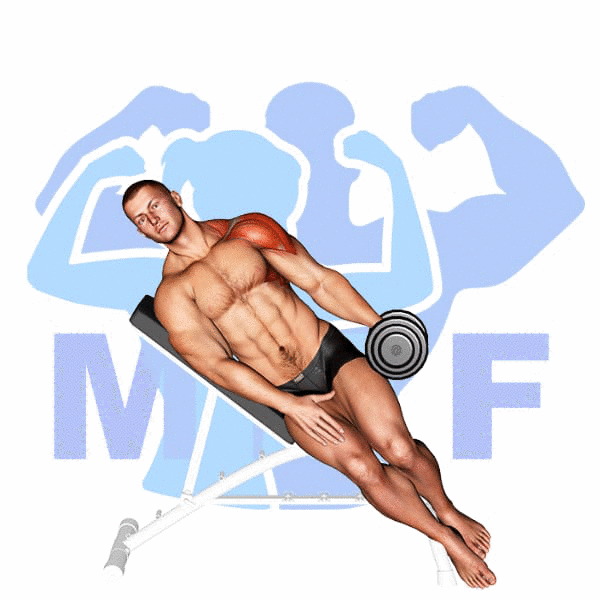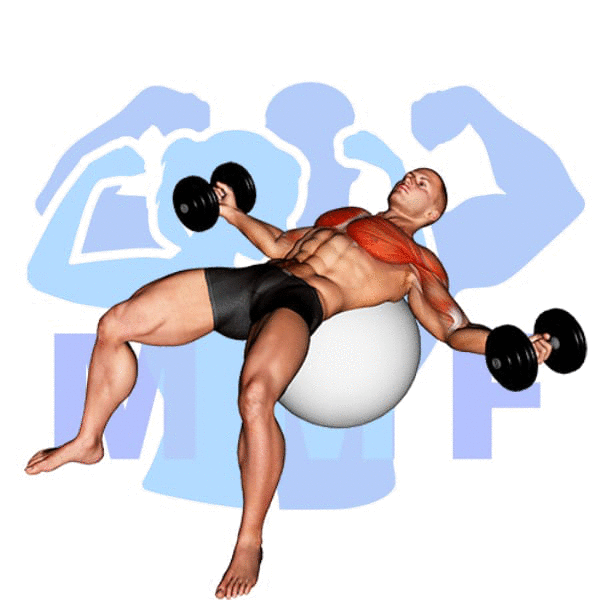Are you tired of feeling shoulder pain during your workout? Do you struggle with performing the lying dumbbell rear lateral raise? Don’t worry, you’re not alone. Many people experience discomfort in their shoulders when performing this exercise. The common cause of this issue is improper form and lack of knowledge of the muscle groups being targeted. Luckily, there are simple solutions to help alleviate this pain and improve your form. In this blog post, we will explore the proper technique for performing the lying dumbbell rear lateral raise and provide tips to help you strengthen and tone your shoulders without pain.
Lying Dumbbell Rear Lateral Raise Summary
- Primary Muscles: Deltoid – Lateral
- Secondary Muscles: Deltoid – Anterior, Serratus Anterior, Supraspinatus, Trapezius – Lower, and Trapezius – Middle
- Equipment: Dumbbells and Bench
- Mechanics Type: Isolation
- Force: Push
- Utility: Auxiliary

Lying Dumbbell Rear Lateral Raise Instructions
- You can begin by choosing your dumbbells and lying chest down on a flat bench.
- Pick the dumbbells of the ground and don’t let them touch the ground during the exercise, maintain your elbows locked in this position through the exercise.
- Next, lift the dumbbells up to the side like you are spreading your wings to fly, if your arms were wings that is.
- Then, pause at the top and slowly lower them back down to the starting position.
- Continue flying until you have concluded a complete set.
Video Tutorial
Lying Dumbbell Rear Lateral Raise Muscles
Target (Agonist)
Synergists
Dynamic Stabilizers
- None
Stabilizers
- Levator Scapulae
- Trapezius – Upper
- Wrist Extensors
Antagonist Stabilizers
- None

Benefits of Lying Dumbbell Rear Lateral Raise
The Lying Dumbbell Rear Lateral Raise is an effective exercise for targeting the lateral (side) deltoid muscle. When performed with proper form, this exercise can help to strengthen and tone the lateral deltoid, as well as improve posture and balance. The Lying Dumbbell Rear Lateral Raise also works the stabilizing muscles in the shoulder, such as the rotator cuff muscles, to help improve shoulder stability and reduce the risk of injury. Additionally, this exercise can be used to warm up the shoulder joint before engaging in more strenuous activities.
Tips for Performing Lying Dumbbell Rear Lateral Raise
Should you desire to experience the best results, you should always take advantage of these simple tips. Similarly, if you prefer to reduce the likelihood of receiving injuries, you must learn these tips.
- Focus On Inhaling And Exhaling. With this and most exercises respiration is important. You need to be breathing out during the primary muscle contraction and inhaling when your target muscles are expanding.
- Push Your Lifting To Near Failing To Help You Boost The Teardown Of Your Muscles. You should make sure you’ve put in place effective safety precautions any time you’re lifting to near failure.
- Have A Partner So That You Stress Your Body Past Breakdown. You can only go so far by yourself, a partner can easily help you to move your muscular tissue further than where you alone will be able to get. Consequently you will definitely work your muscle tissue down even more and therefore they is going to build back more substantial thru rest and recovery.
- Selecting Your Rest Time That Should Be Small, Yet You Can Nonetheless Complete A Entire Set. Whenever your rest is to quick you might be unable to carry out the whole set, if perhaps it is too lengthy you will be just waisting time.
- Improve Your Form In Advance Of You Increase The Load. getting ideal form will assist preventing injuries and faltering earlier. Excellent Form can assist you to grow muscle tissue quicker.
Benefits and Tips Video
Frequent Mistakes To Avoid
You must avoid these regular issues to build and maintain quality technique and muscle growth. Additionally, when you keep away from these issues you will prevent the odds of having injuries.
- Don’t begin using improper technique. Incorrect technique is definitely the fast path to obtain a physical injury.
- You Must Not Exercise Alone. Your companion may be a good motivator. A training partner can be beneficial spotter.
- Avoid The Urge To Pass-Up Your Cooldown. You should have longer recovery time and more soreness if you ignore your cooldown.
Find More Dumbbell Exercises Here
Variations and Complementary Exercises
For those who are looking to mix up their shoulder workout, there are several variations, complementary, and alternative exercises that can be used in place of or to supplement the Lying Dumbbell Rear Lateral Raise. These exercises will target the same muscles as the Lying Dumbbell Rear Lateral Raise, allowing you to get a full shoulder workout with a variety of exercises.
One Arm Band Lateral Raise

The One Arm Band Lateral Raise is a great complementary or alternative exercise for the Lying Dumbbell Rear Lateral Raise. This exercise is performed standing up and requires you to hold one end of the band in each hand with arms extended out to the side. From there, you raise your arms straight up, maintaining tension on the band throughout the movement. This exercise targets the same muscles as the lying dumbbell rear lateral raise, but by using a band, it requires you to stabilize your core throughout the movement. This can help to further develop your core strength and stability.
Seated Dumbbell Lateral Raise

The Seated Dumbbell Lateral Raise is a great complementary or alternative exercise to the Lying Dumbbell Rear Lateral Raise. This exercise helps to strengthen the shoulder muscles by working the middle deltoids in an upright position. To perform this exercise, sit on a bench with your feet flat on the floor and hold a dumbbell in each hand. Keeping your elbows slightly bent, raise your arms out to the sides until they are in line with your shoulders. Hold for a second, then lower back to the starting position. This exercise is more comfortable than the lying position of the Lying Dumbbell Rear Lateral Raise and still provides a great workout for the shoulder muscles.
Seated Dumbbell Rear Lateral Raise

The Seated Dumbbell Rear Lateral Raise is a great complementary or alternative exercise to the Lying Dumbbell Rear Lateral Raise. This exercise primarily works the rear deltoids and is great for adding strength and definition to the shoulders. It is performed by sitting on a bench with a dumbbell in each hand and palms facing inwards. While keeping your back straight and elbows slightly bent, raise the dumbbells out to the side until they are parallel to the ground. Pause at the top of the movement, then slowly lower the weights back to starting position. This exercise can be done with one arm at a time or both arms together. It is a great alternative to the Lying Dumbbell Rear Lateral Raise as it allows for greater control of the weights and more stability throughout the movement.
Check Out These Top Dumbbell Exercises
Single Arm Lateral Cable Raises

The single arm lateral cable raise is a great complementary or alternative exercise to the lying dumbbell rear lateral raise. It works the same muscles, and allows you to use heavier weights for increased strength gains. This exercise is performed by standing next to a cable machine with the cable handle in one hand. You then lift the handle up to shoulder height, keeping your elbow slightly bent and your core engaged throughout. The single arm lateral cable raise is an excellent exercise for building stability and strengthening the back muscles.
Single Dumbbell Front Raise

The Single Dumbbell Front Raise is a great complementary exercise for the Lying Dumbbell Rear Lateral Raise. This exercise helps to target the front of the shoulder, which is often neglected during the Rear Lateral Raise. It is important to perform both exercises in order to ensure balance and symmetry in the shoulder musculature. This exercise can also be used as an alternative if you do not have access to a flat bench or have difficulty lying down on your back. The Single Dumbbell Front Raise can be performed standing, seated, or kneeling and still provide excellent results.
Smith Machine Upright Row

The Smith Machine Upright Row is an excellent alternative or complementary exercise to the Lying Dumbbell Rear Lateral Raise. This exercise targets the same muscles, but works them in a different way. The upright row requires you to lift the barbell straight up from the floor to your chest, engaging the shoulders, trapezius and arms. You can adjust the weight to make it easier or more challenging depending on your fitness level. This exercise is great for building overall shoulder strength and stability, and can be a great addition to any workout routine.
Find More Shoulders Exercises Here
Opposing Complementary Exercises
To complete your workout, it is important to include exercises that work opposing muscle groups. This helps to create balance and ensure that you are working all the necessary muscles for optimal results. The following exercises will work the opposing muscle groups of the lying dumbbell rear lateral raise.
Decline Dumbbell Twist Fly

The Decline Dumbbell Twist Fly is an excellent complement to the Lying Dumbbell Rear Lateral Raise, as it works the opposing muscle group. The Decline Dumbbell Twist Fly works the anterior deltoids, which are located on the front of the shoulder. This exercise requires you to lift and twist the dumbbells from a decline position, which increases the intensity of the exercise and helps to strengthen and tone the anterior deltoids. By using this exercise in combination with the Lying Dumbbell Rear Lateral Raise, you are able to effectively target both the anterior and posterior deltoids, leading to increased strength and definition in the shoulders.
Dumbbell Fly

The Dumbbell Fly is a great exercise to pair with the Lying Dumbbell Rear Lateral Raise. It works the opposing muscle group of the posterior deltoids and is a great way to increase overall shoulder strength and mobility. The Dumbbell Fly works the anterior deltoids, pectoralis major, and biceps in a coordinated way to complete the pressing movement. The slight bend in the elbow throughout the exercise helps to activate the biceps and triceps, while the pressing movement engages the chest muscles. This exercise is a great complementary move to the Lying Dumbbell Rear Lateral Raise, as it helps to build both strength and balance in the shoulder area.
Incline Dumbbell Fly

The Incline Dumbbell Fly is a great complement to the Lying Dumbbell Rear Lateral Raise exercise. While the Lying Dumbbell Rear Lateral Raise focuses on strengthening the posterior deltoids, the Incline Dumbbell Fly works the anterior deltoids. This exercise is performed by lying on an incline bench with a dumbbell in each hand, arms extended to the sides and palms facing each other. The exerciser then brings the dumbbells together in front of them, focusing on squeezing their chest muscles, before slowly returning to the starting position. By performing both exercises, exercisers can ensure they are working both the anterior and posterior deltoids of the shoulder for balanced strength.
Get Your Rear in Gear with Lying Dumbbell Raises
One effective exercise for targeting the rear deltoids is the lying dumbbell rear lateral raise. This exercise involves lying face down on a flat bench and lifting light weights out to the sides of your body with straight arms. The key is to focus on squeezing your shoulder blades together and keeping your arms in line with your shoulders throughout the movement. Make sure to use a weight that challenges you, but still allows you to maintain proper form. Incorporating this exercise into your routine can help build stronger and more defined rear delts.
References: Wikipedia | ExRx.net | PubMed.gov | Comprehensive List of Shoulders Dumbbell Exercises




